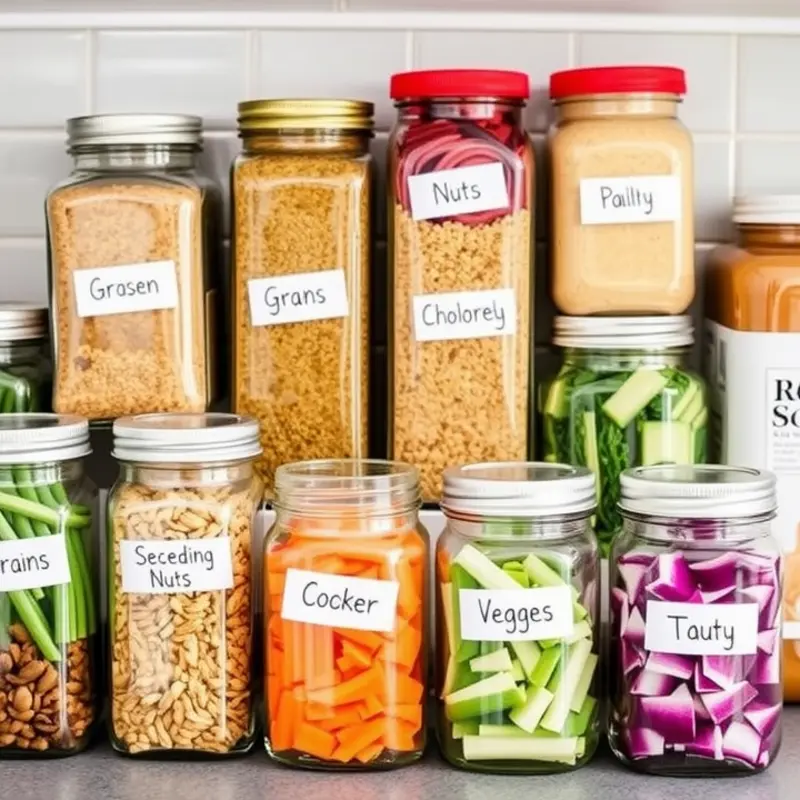Eating healthy doesn’t have to be complicated or time-consuming. By making mindful choices and incorporating tasty whole foods into your meals, you can elevate not only your nutrition but also your overall well-being. This guide offers approachable and practical ideas for anyone looking to embrace a health-conscious lifestyle, whether you’re just getting started or are looking to rejuvenate your current eating habits.
Incorporating Fresh Foods Into Your Diet

Incorporating fresh fruits and vegetables into your daily diet need not be a daunting task. It can be enjoyable and fulfilling when approached with simplicity in mind. Visualize your meals as a blank canvas, waiting to be adorned with vibrant colors and textures that fresh produce offers.
Let’s start with breakfast, the most important meal of the day. Elevate your morning routine by adding fresh fruits to your yogurt or oatmeal. A handful of berries or slices of banana not only enhances the flavor but also provides essential nutrients. Mixing fruits with your smoothie is another excellent option. Consider a base of leafy greens, like spinach, for a nutritional boost without altering the taste significantly.
Lunch offers a world of possibilities to incorporate a rainbow of vegetables. A fresh salad with a variety of greens, tomatoes, and peppers can be both refreshing and satisfying. For a more substantial dish, consider adding roasted vegetables to your grain bowls or wraps. Pairing these with a lean protein ensures a balanced meal. Experiment with different dressings and toppings, but keep it light to let the vegetables’ natural taste shine through.
When dinnertime rolls around, fresh vegetables can transform a meal into a feast. Whether you are planning a quick stir-fry or a slow-cooked stew, vegetables can be the star attraction. Consider roasting a mix of your favorite vegetables, which develops a deep flavor profile and requires minimal preparation.
To further simplify this process, consider the art of practical ingredient batching, which can make fresh foods more accessible daily. Learn more about this technique here. By preparing your vegetables in bulk, you can store them for quick and easy meal incorporation throughout the week.
Remember, buying seasonal produce not only supports local growers but also ensures the freshest ingredients with the best taste. Visit a local farmers’ market or join a community-supported agriculture program to source these ingredients.
Storing fresh produce correctly will extend its shelf life and retain its nutritional value. For tips on eco-friendly storage, which minimizes waste, explore methods of handling specific types of vegetables. Choose airtight containers or reusable produce bags to keep your fruits and vegetables crisp and fresh.
Incorporating fresh foods doesn’t stop with meals. Consider snacks in your fresh food strategy as well. Carrots with hummus or apple slices with nut butter are nutritious options that are quick to prepare and easy to enjoy.
By adopting these straightforward strategies, you can transform your meals into colorful, nutrient-dense experiences. Fresh fruits and vegetables are not only central to a balanced diet, but they also bring joy and satisfaction to your dining occasions.
Quick and Nutritious Meal Prep Tips

Achieving a balanced diet while managing a packed schedule can seem daunting. However, with the right approach to meal preparation, you can always have healthy options available. The secret to effective meal prep lies in planning, variety, and smart storage techniques.
Start by dedicating a specific time each week to plan and prepare your meals. This could be a couple of hours during the weekend. Begin with a meal plan that outlines what you’ll eat each day, focusing on incorporating diverse ingredients. Planning ensures you use ingredients effectively, reducing food waste and saving time during the week.
When preparing meals in advance, think about the ingredients that form the base of your diet. Cooking large batches of grains such as quinoa, brown rice, or whole grain pasta provides a versatile foundation for your meals. You can easily pair them with a range of proteins and vegetables, creating a variety of balanced dishes.
Invest in stackable containers to save space and keep your meals organized in the fridge or freezer. Labels can help you keep track of what you’ve cooked and ensure that you’re rotating meals to avoid monotony. Use see-through containers to quickly visualize your options and make mealtime decisions swift and straightforward.
Another tip is to use different cooking techniques, like roasting an array of vegetables at once. Consider incorporating colorful bell peppers, carrots, zucchini, and sweet potatoes for a vibrant and healthy selection. Roasting enhances flavors and can be done quickly, allowing you to batch cook while putting minimal effort into seasoning.
Emphasize cooking proteins that can be utilized in multiple ways. Grilled chicken breasts, for example, can be sliced for salads, chopped into stir-fries, or shredded for tacos. Consider trying out different seasonings to keep flavors interesting and avoid mealtime fatigue.
For snack time or quick breakfast options, smoothies can be prepped and frozen in jars. Simply blend and freeze ingredients such as berries, spinach, and protein powder in advance. Defrost a jar overnight, and you have a nutritious grab-and-go option.
Keeping your kitchen well-stocked with long-lasting staples ensures you always have nutritious options at hand. Storing sauces safely can enhance the flavor profile of your dishes, making multiple meal transformations possible from the same base ingredients.
Remember that meal prep doesn’t need to be a solitary chore. Involve family or friends to make it a social activity. Sharing the workload makes it quicker and provides an opportunity to exchange useful tips and recipes.
By implementing these strategies, you equip yourself with the tools needed to maintain a healthy diet regardless of how busy life becomes. Smart meal prepping not only saves time but also fosters more mindful eating habits, ensuring every meal is as nourishing as it is convenient.
Final words
Healthy eating is all about making small, achievable changes that can lead to significant improvements in your well-being. By incorporating fresh fruits and vegetables into every meal and practicing effective meal prep strategies, you can maintain a nutritious diet without sacrificing taste or convenience. Remember, each meal is an opportunity to nourish your body, and with a little planning and creativity, healthy eating will soon become a natural part of your lifestyle. Embrace these everyday healthy eating ideas and watch how they positively impact your health journey.







